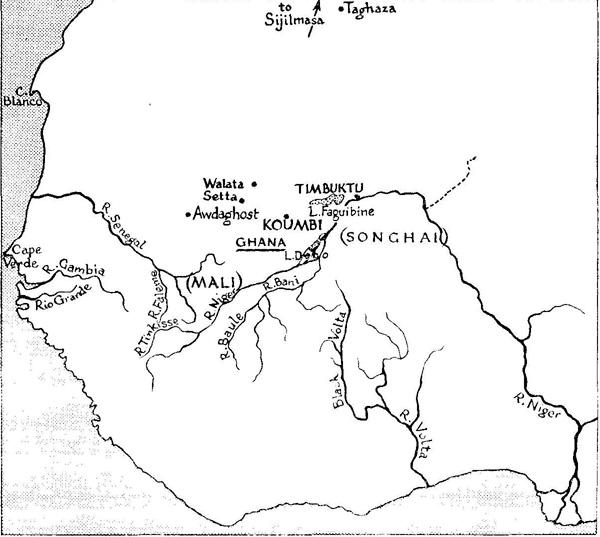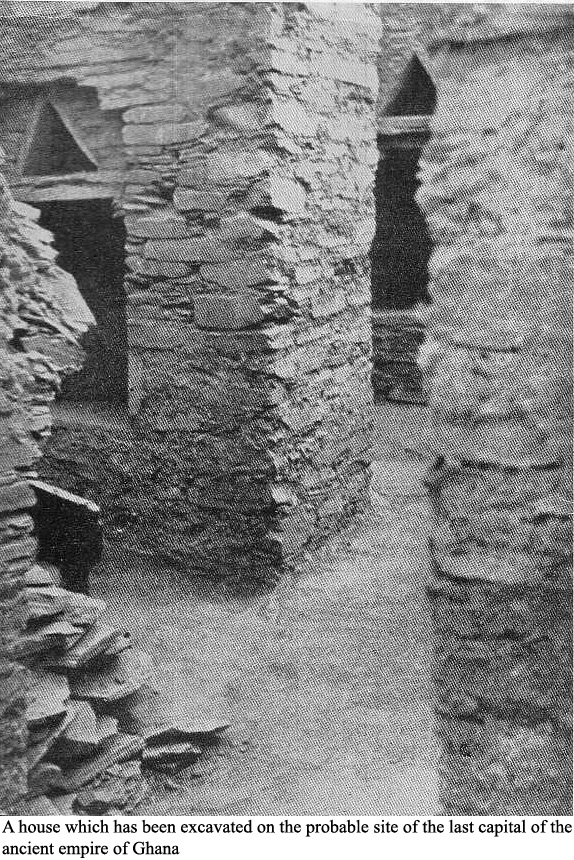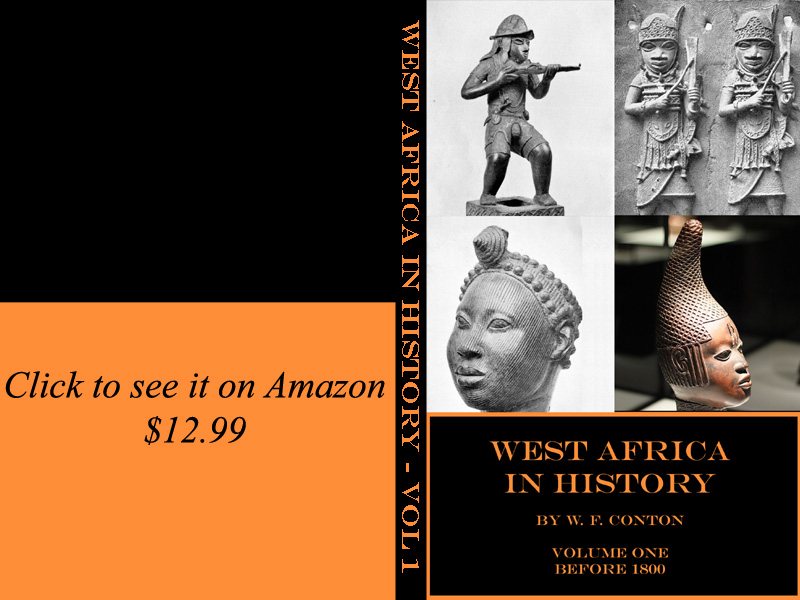The
Empire of Ghana
by
W.F. Conton
by
W.F. Conton
Excerpts from West Africa in History
Ghana was a negro empire. Some history books may give you the impression that, because for brief periods of its history it fell under the rule of non-negro people, it was therefore not a true negro state. Such an impression would be false. Most of the people of the Empire were Soninkes, members of the very large Mande-speaking group of negro tribes. Moreover the Empire was self-governing during nearly the whole of its existence. The fact that between 1076 and 1088 it was ruled by Berbers does not make it a Berber state, any more than the fact that the Gold Coast was ruled by Britain from 1821 to 1957 makes modern Ghana a British state.
The name ‘Ghana’ was originally the title of an Emperor, like ‘Alafe’ or ‘Alafin’. It was later also used as the name of his court, the place from which he ruled. This court was not necessarily always in the same town. For much of the period of the Empire’s existence the court was in a town called Koumbi. But it is important to remember that the boundaries of neither capital nor Empire were as firmly fixed as are those of modern cities and states.
From the fourth century onwards the camel was increasingly used by the Berbers of North Africa as a means of transport in the trade across the Sahara. As an indirect result of this use of the camel, the Muslims spread in increasing numbers in the late seventh century, and many of the pagans in the Empire were converted to Islam.
 The Empire
was very rich in gold, which was the main
commodity of that trade. Many Arab writers bear witness to this wealth.
Al-Fazari, whom I have already mentioned, called Ghana
simply ‘the land of gold’. Al-Masudi, writing in Baghdad in the tenth
century, says that Ghana’s gold was actually ‘visible on the ground’.
Ibn Hawqal, a traveller from Baghdad to Ghana in the early 970s, called
the Emperor of Ghana ‘the richest in the world because of his gold’;
and in those days Baghdad was a city whose people were in touch with
many parts of Europe, Asia, and North Africa. About 100 years after lbn
Hawqal’s time Al-Bakri confirms eloquently that Ghana was extremely
rich. He had never visited Africa - his home was in Cordoba in Spain -
but he was obviously a man who had read widely. He tells us how gold
was to be found everywhere in the Ghana court - in the Emperor's cap
(how this reminds us of the modern Ghanaian chief!), the horses’
trappings, the pages’ swords and shields. Yet another hundred years and
Al-Gharnati, another Arab author, tells us (in about 1162) that
salt in Ghana was some times worth more than its weight in gold, for
the latter was as plentiful as the former was scarce. The most striking
reference to the wealth of Ghana, however, had been made just eight
years before this, in a geography written by Idrisi in 1154. Idrisi
tells us that the Emperor of Ghana tethered his horse to a nugget of
pure gold weighing thirty pounds. Even if, as Al-Bakri had told us
earlier, the horses of Ghana were small, and the Emperor had a monopoly
of all nuggets (the people having to be content with gold dust), we
cannot fail to be impressed that so much gold could be spared for so
lowly a purpose. We shall come across other references to this
particular nugget later, so there seems little doubt that Idrisi was
writing the truth. Besides gold, there was silk in Ghana, the Emperor
wearing a mantle of this expensive Oriental material.
The Empire
was very rich in gold, which was the main
commodity of that trade. Many Arab writers bear witness to this wealth.
Al-Fazari, whom I have already mentioned, called Ghana
simply ‘the land of gold’. Al-Masudi, writing in Baghdad in the tenth
century, says that Ghana’s gold was actually ‘visible on the ground’.
Ibn Hawqal, a traveller from Baghdad to Ghana in the early 970s, called
the Emperor of Ghana ‘the richest in the world because of his gold’;
and in those days Baghdad was a city whose people were in touch with
many parts of Europe, Asia, and North Africa. About 100 years after lbn
Hawqal’s time Al-Bakri confirms eloquently that Ghana was extremely
rich. He had never visited Africa - his home was in Cordoba in Spain -
but he was obviously a man who had read widely. He tells us how gold
was to be found everywhere in the Ghana court - in the Emperor's cap
(how this reminds us of the modern Ghanaian chief!), the horses’
trappings, the pages’ swords and shields. Yet another hundred years and
Al-Gharnati, another Arab author, tells us (in about 1162) that
salt in Ghana was some times worth more than its weight in gold, for
the latter was as plentiful as the former was scarce. The most striking
reference to the wealth of Ghana, however, had been made just eight
years before this, in a geography written by Idrisi in 1154. Idrisi
tells us that the Emperor of Ghana tethered his horse to a nugget of
pure gold weighing thirty pounds. Even if, as Al-Bakri had told us
earlier, the horses of Ghana were small, and the Emperor had a monopoly
of all nuggets (the people having to be content with gold dust), we
cannot fail to be impressed that so much gold could be spared for so
lowly a purpose. We shall come across other references to this
particular nugget later, so there seems little doubt that Idrisi was
writing the truth. Besides gold, there was silk in Ghana, the Emperor
wearing a mantle of this expensive Oriental material. But iron was in some ways an even more important
mineral
to the people of Ghana than gold. We do not know whether they learnt
the craft of ironwork from the people who made the Nok figurines, and
who seem to have been scattered at one time in many different parts of
West Africa. But certainly El Zhouri, another Arab writer, notes that
before 1150 the people of the Empire of Ghana were successfully
attacking with swords and lances other peoples ‘who know not iron and
fight with bars of ebony’. I have already referred1 to the
great advantages which a people who have both the ore and the skill for
making iron weapons and implements possesses over others.
But iron was in some ways an even more important
mineral
to the people of Ghana than gold. We do not know whether they learnt
the craft of ironwork from the people who made the Nok figurines, and
who seem to have been scattered at one time in many different parts of
West Africa. But certainly El Zhouri, another Arab writer, notes that
before 1150 the people of the Empire of Ghana were successfully
attacking with swords and lances other peoples ‘who know not iron and
fight with bars of ebony’. I have already referred1 to the
great advantages which a people who have both the ore and the skill for
making iron weapons and implements possesses over others.
Now 900 years ago Al-Bakri had written of just
two such
towns as comprising together Ghana’s capital. One, he wrote, was...
We cannot say definitely either where these people came from originally, nor exactly where they all went. Mande-speaking people are found today in many parts of West Africa; but they are concentrated in and around the borders of Guinea in the greatest numbers. The Mende people, Sierra Leone’s largest tribe, also have Mande-speaking ancestors, and...
Thus the most we can say confidently at present is that the citizens of ancient Ghana were pure negroes who must have come originally from a part of West Africa where the Mande group of languages was spoken, and that they probably dispersed to various parts of West Africa on the collapse of the Empire, taking their customs with them.
This collapse came as a result of repeated attacks by the many enemies on the Empire’s borders. These attacks must have started very soon after Ghana reached the height of its fame, and its great wealth was the attraction. A historian called Abderrahman as-Sadi, writing in Timbuktu in 1652, says...
We cannot say definitely either where these people came from originally, nor exactly where they all went. Mande-speaking people are found today in many parts of West Africa; but they are concentrated in and around the borders of Guinea in the greatest numbers. The Mende people, Sierra Leone’s largest tribe, also have Mande-speaking ancestors, and...
Thus the most we can say confidently at present is that the citizens of ancient Ghana were pure negroes who must have come originally from a part of West Africa where the Mande group of languages was spoken, and that they probably dispersed to various parts of West Africa on the collapse of the Empire, taking their customs with them.
This collapse came as a result of repeated attacks by the many enemies on the Empire’s borders. These attacks must have started very soon after Ghana reached the height of its fame, and its great wealth was the attraction. A historian called Abderrahman as-Sadi, writing in Timbuktu in 1652, says...
NEXT(The Empire of Mali)
PREVIOUS(Africa
in Classical Times)
